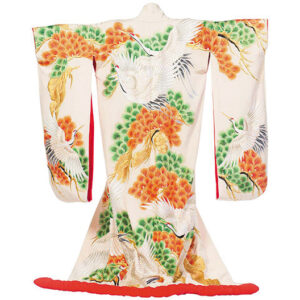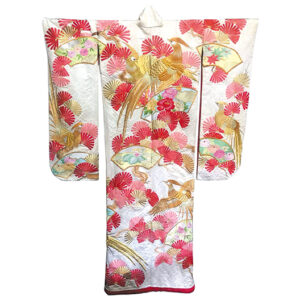 By Anne Gilbert
By Anne Gilbert Kimonos have come a long way from Geisha girl gowns to 21st century fashion statements. They were also made for men and still are.
When you can find them, not only antique but early 20th century Japanese kimonos are framed or considered wearable art. The best examples can be costly. When I recently scanned them I found one dealer pricing a 1930s wedding kimono at $3,800. Another dealer priced a 1930s, silk Art Deco motif kimono at $1,400. Even in 15th and 16th century Japan they were considered works of art, worthy to display on racks of ivory, polished bamboo and ebony.
CLUES: Styles changed over the years. Historically there are three main types of kimonos, made for different functions. The “yukata” was an unembroidered print robe made for home and bath.
The designs in the textiles used several techniques that included dyeing, embroidering, brocading, appliquéing, raised gold-thread repousse work and hand painting.
The earliest style was the “kosode,” a heavy, undecorated garment worn under heavy, formal court robes. By the 17th and 18th centuries, colorful, bold designs appeared, turning the look of the kimono and other Japanese textiles into an exciting art form. The finest examples were done for the Kabuki theater. Examples can be seen in the 18th, 19th century woodcut Kabuki theater woodcut theater prints. Brightly colored floral motifs often were enriched with silver foil. Other times gold foil backgrounds were strewn with flowers and dramatized with water fowl.
Important designs used in different forms were the flowering cherry tree, plum and bamboo. Among the popular birds used in the designs were the heron, phoenix and falcon. Often the geometric designs showed a Chinese influence, such as the thunder-line and trellis motifs.
 Family crest motifs were yet another type of embroidery. They were often printed on the fabric and embroidered.
Family crest motifs were yet another type of embroidery. They were often printed on the fabric and embroidered. Americans got their first glimpse of them in quantity, first at the Philadelphia Centennial Exposition in 1876, and by tourists who brought them back until World War 11. The next influx of Japanese textiles, after that, included elaborate 20th century obis (wide bands of cloth wrapped around the waist.)
More changes were in store for those created in the Art Deco style of the 1920s, 30s. Some motifs used stylized graphic designs that were sometimes humorous.
It took the devastation of the Pacific War that ended the tradition of wearing kimonos every day. These days they are worn for special occasions.
PHOTO CAPTION: Japanese wedding kimono, 1930s. PHOTO CREDIT: 1ST Dibs PHOTO CAPTION: Art Deco kimono. PHOTO CREDIT: 1ST Dibs















Follow Us